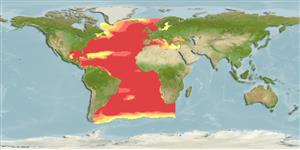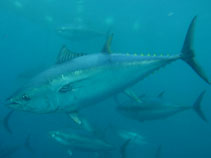Add your observation in Fish Watcher
| Native range | All suitable habitat | Point map | Year 2050 |

|
| This map was computer-generated and has not yet been reviewed. |
| Thunnus thynnus AquaMaps Data sources: GBIF OBIS |
Upload your photos and videos
Pictures | Videos | Stamps, coins, misc. | Google imageThunnus thynnus
Picture by Ticina, V.
Pictures | Videos | Stamps, coins, misc. | Google imageThunnus thynnus
Picture by Ticina, V.
Norway country information
Common names:
Makrellshørje, Makrellstørje, Sjorje
Occurrence: native
Salinity: marine
Abundance: | Ref:
Importance: | Ref:
Aquaculture: | Ref:
Regulations: | Ref:
Uses: no uses
Comments:
National Checklist:
Country Information: https://www.cia.gov/library/publications/resources/the-world-factbook/geos/no.html
National Fisheries Authority: http://odin.dep.no/fid/eng/
Occurrences: Occurrences Point map
Main Ref: Collette, B.B. and C.E. Nauen, 1983
National Database:
Occurrence: native
Salinity: marine
Abundance: | Ref:
Importance: | Ref:
Aquaculture: | Ref:
Regulations: | Ref:
Uses: no uses
Comments:
National Checklist:
Country Information: https://www.cia.gov/library/publications/resources/the-world-factbook/geos/no.html
National Fisheries Authority: http://odin.dep.no/fid/eng/
Occurrences: Occurrences Point map
Main Ref: Collette, B.B. and C.E. Nauen, 1983
National Database:
Common names from other countries
Classification / Names Nomi Comuni | Sinonimi | Catalog of Fishes(Genere, Specie) | ITIS | CoL | WoRMS | Cloffa
> Scombriformes (Mackerels) > Scombridae (Mackerels, tunas, bonitos) > Scombrinae
Etymology: Thunnus: Greek, thynnos = tunna (Ref. 45335).
More on author: Linnaeus.
Etymology: Thunnus: Greek, thynnos = tunna (Ref. 45335).
More on author: Linnaeus.
Environment: milieu / climate zone / depth range / distribution range Ecologia
marino; salmastro; oceanodromo (Ref. 51243); distribuzione batimetrica 0 - 985 m (Ref. 55291), usually 0 - 100 m. Subtropical; 3°C - 30°C (Ref. 88796); 69°N - 58°S, 99°W - 42°E
Distribuzione Stati | Aree FAO | Ecosystems | Presenze | Point map | Introduzioni | Faunafri
Western Atlantic: Labrador and Newfoundland to Gulf of Mexico, and Caribbean Sea to Venezuela and Brazil. Eastern Atlantic: Lofoten Islands off Norway to Canary Islands, including the Mediterranean and the southern part of the Black Sea (Ref. 6769). Reported from Mauritania (Ref. 5377). There is a subpopulation off South Africa. Highly migratory species.
Length at first maturity / Size / Peso / Age
Maturity: Lm 103.5, range 97 - 110 cm
Max length : 458 cm TL maschio/sesso non determinato; (Ref. 26340); common length : 200 cm FL maschio/sesso non determinato; (Ref. 168); peso massimo pubblicato: 684.0 kg (Ref. 26340); Età massima riportata: 32 anni (Ref. 5810)
Max length : 458 cm TL maschio/sesso non determinato; (Ref. 26340); common length : 200 cm FL maschio/sesso non determinato; (Ref. 168); peso massimo pubblicato: 684.0 kg (Ref. 26340); Età massima riportata: 32 anni (Ref. 5810)
Short description Chiavi di identificazione | Morfologia | Morfometria
Spine dorsali (totale) : 12 - 14; Raggi dorsali molli (totale) : 13 - 15; Spine anali: 0; Raggi anali molli: 13 - 16; Vertebre: 39. A very large species, deepest near the middle of the first dorsal fin base. The second dorsal fin higher than the first; the pectoral fins are very short, less than 80% of head length. Swim bladder present. Lower sides and belly silvery white with colorless transverse lines alternated with rows of colorless dots. The first dorsal fin is yellow or bluish; the second reddish-brown; the anal fin and finlets dusky yellow and edged with black; the median caudal keel is black in adults. May be confused with several other tunas, these are typically much smaller and easily distinguished by specific patterns of stripes, bands or dots.
Oceanic but seasonally coming close to shore. They school by size, sometimes together with albacore, yellowfin, bigeye, skipjack etc. Visual predators (Ref. 88866) preying on small schooling fishes (anchovies, sauries, hakes) or on squids and red crabs. Live up to 40 years in the western Atlantic (Ref. 88822). Weight up to 900 kg (Ref. 88823). Eggs and larvae are pelagic (Ref. 6769). Juvenile growth is rapid (about 30 cm / year) but slower than in other tuna
and billfish species (Ref. 88867). Adult growth is considerably slower, with about 10 years needed to reach two thirds of maximum length. Become rare because of massive overfishing (Ref. 35388).
Life cycle and mating behavior Maturità | Riproduzione | Deposizione | Uova | Fecundity | Larve
Oviparous batch spawner, with an inter-spawning interval of 1-2 days in the Mediterranean Sea (Ref. 88871). Females larger than 205 cm fork length are estimated to have a mean fecundity of 30-60 and 13-15 million eggs, in the western and eastern Atlantic respectively (Ref. 40805, Ref. 88871). Spawning occurs when sea surface temperatures are between 22.6-27.5 ºC and 22.5-25.5 ºC in the Gulf of Mexico and Mediterranean Sea respectively (88868). Spawning occurs between June and August in the Mediterranean Sea (Ref. 88868). Eggs are released directly to the water column and hatch after 2 days (Ref. 88823). At 24°C, embryo development lasts about 32 hours and larval stages about 30 days. Egg size 1.0 mm, larval length at hatching 2.8 mm.
Spawning grounds are mainly known from the Gulf of Mexico and the Mediterranean Sea, but the presence of mature individuals and larvae far from these areas (e.g. Bahamas and central North Atlantic Ocean) suggest that other spawning grounds may also be utilized (Ref. 88873, Ref. 88874, Ref. 88872). Appears to display homing behaviour with (western-tagged individuals migrating back to specific spawning sites either in the Gulf of Mexico or the Mediterranean Sea) (Ref. 88872, Ref. 88870). Fidelity to natal areas seem to occur once individuals reach maturity, i.e. after returning to either the western or eastern spawning grounds (Ref. 88868).
Main reference
Upload your references | Bibliografia | Coordinatore : Collette, Bruce B. | Collaboratori
Collette, B.B., 1999. Mackerels, molecules, and morphology. p. 149-164. In B. Séret and J.-Y. Sire (eds.) Proc. 5th Indo-Pac. Fish Conf., Noumea, Paris. (Ref. 33246)
IUCN Red List Status (Ref. 130435: Version 2024-2)
Least Concern (LC) ; Date assessed: 15 January 2021
Threat to humans
Harmless
Human uses
Pesca: commerciale; Acquacoltura: commerciale; Pesce da pesca sportiva: si
FAO(Aquaculture systems: production; pesca: production, species profile; publication : search) | FIRMS (Stock assessments) | FishSource | Sea Around Us
Informazioni ulteriori
Population dynamics
Growth parameters
Max. ages / sizes
Length-weight rel.
Length-length rel.
Length-frequencies
Mass conversion
Reclutamento
Abbondanza
Growth parameters
Max. ages / sizes
Length-weight rel.
Length-length rel.
Length-frequencies
Mass conversion
Reclutamento
Abbondanza
Physiology
Body composition
Nutrients
Oxygen consumption
Swimming type
Swimming speed
Visual pigments
Fish sound
Diseases & Parasites
Toxicity (LC50s)
Body composition
Nutrients
Oxygen consumption
Swimming type
Swimming speed
Visual pigments
Fish sound
Diseases & Parasites
Toxicity (LC50s)
Human related
Aquaculture systems
Profili di acquacoltura
Varietà
Ciguatera cases
Stamps, coins, misc.
Aquaculture systems
Profili di acquacoltura
Varietà
Ciguatera cases
Stamps, coins, misc.
Strumenti
Bio-Quiz | E-book | Giuda pratica | Chiavi di identificazione | Generatore frequenze di lunghezza | Strumento Parametri Biologici | Mappa dei ritrovamenti | Classification Tree
| Catch-MSY |
Special reports
Download XML
Fonti Internet
Aquatic Commons | BHL | Cloffa | BOLDSystems | Websites from users | Check FishWatcher | CISTI | Catalog of Fishes(Genere, Specie) | DiscoverLife | ECOTOX | Faunafri | Fishtrace | GenBank(genome, nucleotide) | GloBI | GOBASE | | Google Books | Google Scholar | Google | IGFA World Record | MitoFish | Database Nazionali | Otolith Atlas of Taiwan Fishes | Acquari pubblici | PubMed | Reef Life Survey | Scirus | SeaLifeBase | Tree of Life | Wikipedia(Go, ricerca) | World Records Freshwater Fishing | Zoological Record
Estimates based on models
Preferred temperature (Ref. 115969): 7.5 - 24.7, mean 12.6 (based on 3084 cells).
Phylogenetic diversity index (Ref. 82804): PD50 = 0.5039 [Uniqueness, from 0.5 = low to 2.0 = high].
Bayesian length-weight: a=0.01230 (0.01003 - 0.01509), b=3.03 (2.99 - 3.07), in cm Total Length, based on LWR estimates for this species (Ref. 93245).
Trophic level (Ref. 69278): 4.5 ±0.8 se; based on diet studies.
Resilienza (Ref. 120179): Medio, tempo minimo di raddoppiamento della popolazione 1.4 - 4.4 anni (tm=3-5; tmax=15; Fec=10 million).
Prior r = 0.24, 95% CL = 0.16 - 0.35, Based on 5 full stock assessments.
Fishing Vulnerability (Ref. 59153): Very high vulnerability (82 of 100).
Climate Vulnerability (Ref. 125649): Moderate vulnerability (38 of 100).




